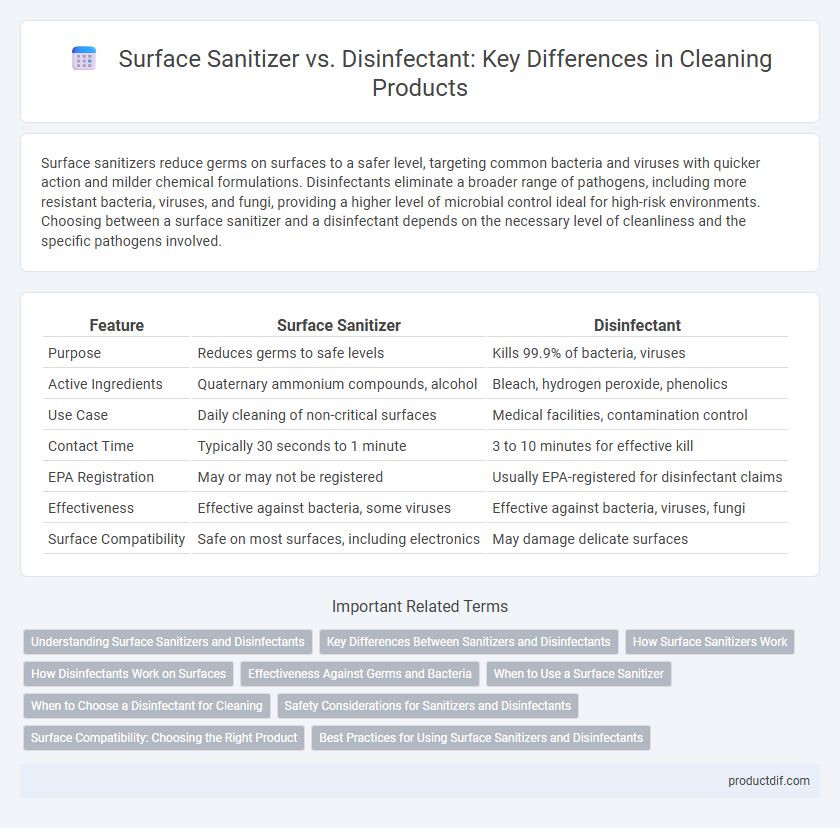Surface sanitizers reduce germs on surfaces to a safer level, targeting common bacteria and viruses with quicker action and milder chemical formulations. Disinfectants eliminate a broader range of pathogens, including more resistant bacteria, viruses, and fungi, providing a higher level of microbial control ideal for high-risk environments. Choosing between a surface sanitizer and a disinfectant depends on the necessary level of cleanliness and the specific pathogens involved.
Table of Comparison
| Feature | Surface Sanitizer | Disinfectant |
|---|---|---|
| Purpose | Reduces germs to safe levels | Kills 99.9% of bacteria, viruses |
| Active Ingredients | Quaternary ammonium compounds, alcohol | Bleach, hydrogen peroxide, phenolics |
| Use Case | Daily cleaning of non-critical surfaces | Medical facilities, contamination control |
| Contact Time | Typically 30 seconds to 1 minute | 3 to 10 minutes for effective kill |
| EPA Registration | May or may not be registered | Usually EPA-registered for disinfectant claims |
| Effectiveness | Effective against bacteria, some viruses | Effective against bacteria, viruses, fungi |
| Surface Compatibility | Safe on most surfaces, including electronics | May damage delicate surfaces |
Understanding Surface Sanitizers and Disinfectants
Surface sanitizers reduce the number of microorganisms on surfaces to a safe level as defined by public health standards, primarily targeting bacteria and viruses without necessarily killing all pathogens. Disinfectants, on the other hand, destroy or inactivate a broader spectrum of harmful microorganisms, including bacteria, viruses, and fungi, making them essential for high-risk areas requiring stringent infection control. Understanding the differences helps in selecting the appropriate product for effective cleaning and preventing disease transmission.
Key Differences Between Sanitizers and Disinfectants
Surface sanitizers reduce bacteria on surfaces to safe levels as defined by public health standards, primarily targeting common germs without necessarily eliminating all pathogens. Disinfectants provide a stronger action, killing a broader range of microorganisms, including viruses, bacteria, and fungi, to achieve near-complete surface sterilization. The choice between sanitizers and disinfectants depends on the required level of microbial control and the specific environment, with disinfectants preferred in healthcare settings for comprehensive germ elimination.
How Surface Sanitizers Work
Surface sanitizers reduce the number of bacteria and viruses on surfaces to a safe level as defined by public health standards by using antimicrobial agents that target and disrupt microbial cell walls or membranes. These products typically contain ingredients like quaternary ammonium compounds or alcohol, which are effective in killing or inhibiting a broad spectrum of microorganisms without damaging the surface. Unlike disinfectants, sanitizers prioritize rapid action and surface compatibility, making them suitable for everyday cleaning in environments like kitchens, schools, and healthcare facilities.
How Disinfectants Work on Surfaces
Disinfectants work on surfaces by destroying or inactivating harmful microorganisms such as bacteria, viruses, and fungi through chemical reactions that disrupt their cell walls or interfere with their essential metabolic processes. Unlike surface sanitizers that only reduce microbial load to safe levels, disinfectants provide a higher level of microbial elimination, ensuring that surfaces are free from pathogens capable of causing infections. Common active ingredients in disinfectants include quaternary ammonium compounds, bleach (sodium hypochlorite), and hydrogen peroxide, each targeting specific types of microbes for effective sanitization.
Effectiveness Against Germs and Bacteria
Surface sanitizers reduce the number of germs and bacteria on surfaces by 99.9%, making them effective for routine cleaning in low-risk environments. Disinfectants eliminate a broader range of pathogens, including viruses, bacteria, and fungi, achieving up to 99.999% kill rates, essential for high-touch or contaminated areas. Choosing between a sanitizer or disinfectant depends on the required level of microbial elimination and the specific pathogens present.
When to Use a Surface Sanitizer
Surface sanitizers are ideal for routine cleaning of high-touch areas like countertops, door handles, and electronics when reducing bacteria to safe levels is sufficient. Use surface sanitizers in environments such as schools, offices, and homes where rapid microbial reduction is needed without the harsh effects of disinfectants. They are preferred when quick drying times and frequent application are important for maintaining ongoing cleanliness.
When to Choose a Disinfectant for Cleaning
Disinfectants are essential for eliminating a wide range of harmful pathogens, including bacteria, viruses, and fungi, making them ideal for high-risk areas like hospitals and kitchens. They work by killing microorganisms on surfaces, which is critical during flu seasons or disease outbreaks to prevent infection spread. Choose a disinfectant over a standard surface sanitizer when thorough microbial elimination is necessary to maintain a hygienic and safe environment.
Safety Considerations for Sanitizers and Disinfectants
Surface sanitizers and disinfectants differ significantly in their chemical compositions and efficacy levels, which impacts safety considerations for their use. Sanitizers generally have lower concentrations of active ingredients, reducing risks of skin irritation and respiratory issues, whereas disinfectants contain stronger chemicals like bleach or quaternary ammonium compounds requiring careful handling, proper ventilation, and adherence to label instructions to prevent toxicity. Users must prioritize protective gloves, avoid mixing with incompatible substances, and ensure surfaces are properly rinsed to minimize potential chemical exposure and health hazards.
Surface Compatibility: Choosing the Right Product
Surface sanitizer and disinfectant differ significantly in chemical composition and potency, impacting surface compatibility and safety. Sanitizers are generally milder, suitable for sensitive materials like wood or painted surfaces, while disinfectants contain stronger agents ideal for non-porous surfaces such as glass, metal, and plastic but may cause damage or discoloration on delicate finishes. Selecting the appropriate product ensures effective microbial control without compromising the integrity or appearance of the surface.
Best Practices for Using Surface Sanitizers and Disinfectants
Surface sanitizers reduce microbial contamination on surfaces to safer levels, while disinfectants eliminate a broader range of pathogens, including viruses and bacteria. Best practices for using surface sanitizers and disinfectants include following manufacturer instructions for contact time, wearing protective gloves, and ensuring proper ventilation during application. Regularly cleaning surfaces before applying these products enhances their effectiveness and prevents the spread of harmful microorganisms.
Surface sanitizer vs disinfectant Infographic

 productdif.com
productdif.com